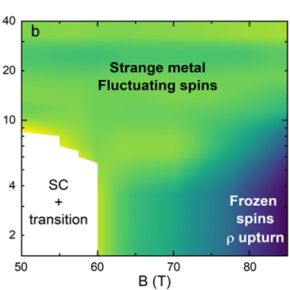Impact of low-energy spin fluctuations on the strange metal in a cuprate superconductor
Strange metals exhibit unusual properties such as a resistivity that scales linearly with temperature. Physicists use magnetic fields as high as 86 T to explore the physics of strange metals in a cuprate superconductor. Close to the critical doping of the pseudogap p* = 0.19, they discover that temperature-linear resistivity exists down to the lowest temperature over an extended range of magnetic field between 60 T and 70 T or so, and disappears above. Indeed, above 70 T, a spin glass phase gradually appears and causes the end of strange metallicity.
The present study was carried out in the following CNRS laboratory:
- Laboratoire national des champs magnétiques intenses (LNCMI, CNRS)
References:
Impact of low-energy spin fluctuations on the strange metal in a cuprate superconductor, D. J. Campbell, M. Frachet, V. Oliviero, T. Kurosawa, N. Momono, M. Oda, J. Chang, D. Vignolles, C. Proust, D. LeBoeuf, Nature Physics - Publié le 30 septembre 2025.
DOI : 10.1038/s41567-025-03034-0
Archive ouverte arXiv

